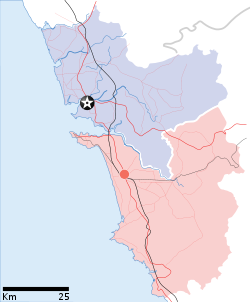| Mapusa | |
| | |
| Coordinates | 15°36′N 73°49′E / 15.60°N 73.82°E |
| Country | |
| State | Goa |
| District(s) | North Goa |
| Mayor | |
| Population | 40,122 (2001[update]) |
| Time zone | IST (UTC+5:30) |
| Area • Elevation | • 15 m (49 ft) |
Mapusa (Konkani: म्हापशें Mhapxem /mʱaːpʃɛ̃ˑ/; Marathi: म्हापसा /mʱaːpsaˑ/) also spelt at Mapuca, Mhapsa or Mapsa is a town in North Goa, India. It is situated 13 km north of the capital Panaji. The town is the headquarters of Bardez taluka. It is located on the main highway NH-17, linking Mumbai to Trivandrum. Under Portuguese rule, the town's name was spelt Mapuçá.
History
Even before the Aryans, or Marathas, or Sultans or the Portuguese invaded Goa, this was an agrarian community with a well established Gaunkari or Community Farming System, where villages formed associations, worked on community land and shared profits. Market day was a major event, with goods brought in from every district to one central area. Mapusa has thus remained a prominent market center for many centuries.
Geography
Mapusa is located at 15°36′N 73°49′E / 15.60°N 73.82°E[1]. It has an average elevation of 15 metres (49 feet).
Mapusa has a tropical climate with temperatures ranging from a high of 37 °C in summer with high levels of humidity to a low of 21 °C in winters.
Demographics
As of 2001[update] India census, Mapusa had a population of 40,122. Males constitute 52% of the population and females 48%. Mapusa has an average literacy rate of 76%, higher than the national average of 59.5%: male literacy is 80%, and female literacy is 73%. In Mapusa, 11% of the population is under 6 years of age.
Economy
Mapusa is close to one of the main centres of Goa's tourism industry. Mapusa's proximity to many beaches in the north Goa makes it a suitable base during the tourist season (October to January). Because it is a mainly commercial town (for locals) with a large resident population, Mapusa has only a limited number of hotels and accommodation.
Mapusa comes alive on Friday, the traditional market day also known as Mapusa Friday Market. People from surrounding villages and towns come to Mapusa to sell their wares. This fair has a lot of local flavour (unlike some other tourist-oriented fairs or markets) and specialises in agricultural produce, vegetables, locally-grown fruit, spices, clothes and even plants (mainly during the monsoon planting season).
Every Friday, the Mapusa Market bulges at the seams, with seemingly every square inch of space occupied by sellers with only just enough room for the prospective buyers, the alleys between the regular stalls being occupied with temporary mats and boards. From lottery tickets displayed in great swathes to barber shops, the bazaar caters for almost every requirement imaginable. There is the fish street, dried fish of all possible variety and whole fresh fish from baby shark and squid to the ubiquitous bangda (mackerel). Fresh fruit and vegetables are gathered together and beautifully displayed, from huge sweet potatoes, and pumpkins and the local shiny red brown Moira bananas to the tiny fresh beans and other pulses.
Education
Mapusa houses quite a good educational institutions; Saraswat Vidyalaya, Purushottom Walawalkar Higher Secondary School, Sridora Caculo College of Commerce & Management Studies, St. Mary's Convent High School, St. Brittos, New Goa high school, Dyan prasarak mandal college(college), St. Xaviers college, St. Xaviers higher secondary school, etc to a name a few.
A village called Siolim is located nearby.
Siolim
Siolim is situated at the Northern west point of the taluka of Bardez. It is about 10 kms from Calangute and 3 kms from Anjuna. This place is filled with lush greenery, and to the northern end of this village, is a bridge built very recently, leading to Morjim.
This place was the first to be developed by the Portuguese. This is the last place where one can find Portuguese styled architecture influenced homes, after which, northwards, consists of very simple homes and cottages. The famous church of St. Anthony lies here. It is said to be one of the most miraculous churches in all of Goa, after St. Francis Xavier in Old Goa or Velha Goa. This church was built by the Franciscan priest in about 1568. It is signified by the statue of St. Anthony holding the snake by a leash, a symbolism of triumph of good over evil. It has witnessed many miracles in the past,as for example, one which occurred in 1600AD, attracted a huge number of locals.
Siolim has become a place of refuge from the encroaching tourist industry in Goa. It is situated just beyond the Siolim range after Vagator, and has shown little signs of interest by tourists.
It consists of two zones called Siolim and Marna. Marna mostly consists of hills, and the two are divided by a small rivulet or inlet of water from the nearby river.
It is a little confusing for new-comers to get to the desired locations in this area, mainly because of its vast landscape and the confusing homes.






0 Comments:
Post a Comment